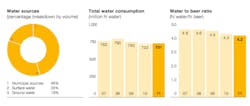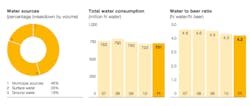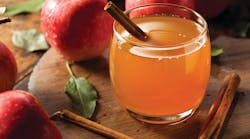In an overall sustainability initiative, global brewer and bottler SABMiller plc is aiming to reduce its water use per hectoliter of beer 25 percent by 2015, according to the group’s 2011 Sustainable Development Summary Report.
SABMiller’s water efficiency has improved by 8 percent since 2008, when the group first set its target to reduce water used in its beer production, the report stated.
The brewer, whose portfolio includes beers such as Miller Genuine Draft and Grölsch, is also one of the largest bottlers of Coca-Cola products in the world. In 2011, the group’s revenue was $28,311 million with earnings before interest, tax, and amortization of $5,055 million and lager production of 218 million hectoliters. Last year, SABMiller used 731 million hectoliters of water in its own beer production processes. The brewer’s average water consumption per hectoliter of beer produced for the last financial year was 4.2 hectoliters, a 3 percent improvement on the previous 12 months.
“As water scarcity becomes more apparent, then so do the risks we potentially face — not least competition for resources, higher costs, the effect on water quality, and the possibility that water shortages will limit production,” the report stated. “These risks are often shared with the community around us.”
SABMiller evaluates the risks to its breweries and bottling plants using a watershed-mapping tool that uses data from the World Business Council for Sustainable Development (WBCSD), which covers all of its operating sites. The company also undertakes Source Vulnerability Assessments (SVAs) at its Coca-Cola bottling plants to determine the sustainability of its water supplies. In September 2010, the group published water footprints of its operations in Peru, Ukraine, Tanzania and South Africa, considered countries at risk of significant water stress. The water footprints show how much water is consumed to produce beer from crop cultivation to waste disposal.
The results of the water footprints varied—ranging from 61 liters of water per liter of beer produced in Peru to 180 liters per liter in Tanzania—illustrating the impact of local factors on water consumed within SABMiller’s value chain, the brewer points out in the report. Crop cultivation accounted for more than 90 percent of water consumed in the four countries analyzed. As a result, SABMiller is working with stakeholders in those countries to develop watershed programs.
To download SABMiller’s 2011 Sustainable Development Summary Report, click here.



